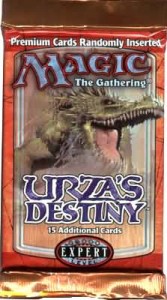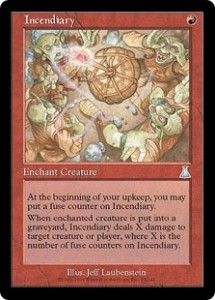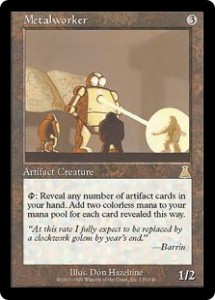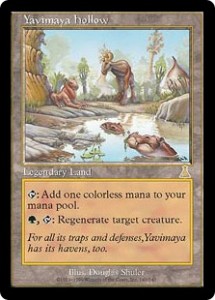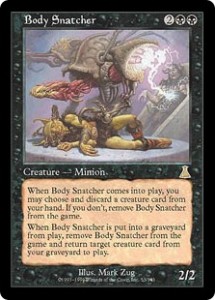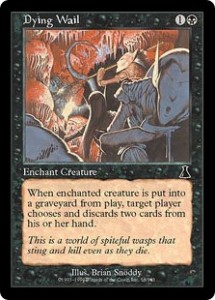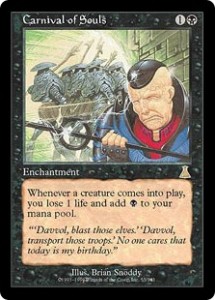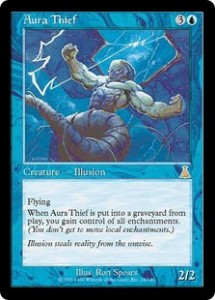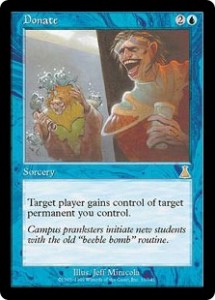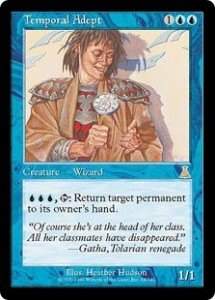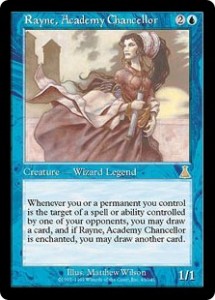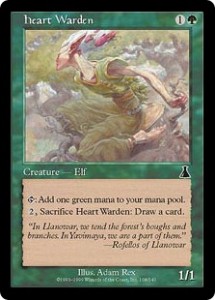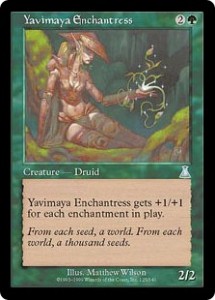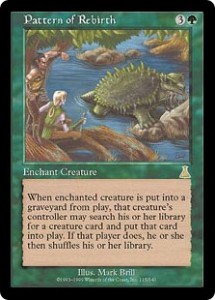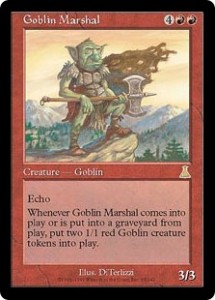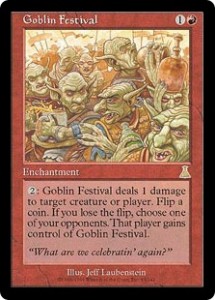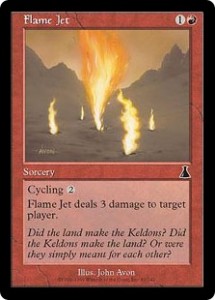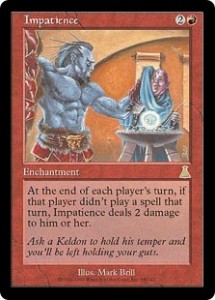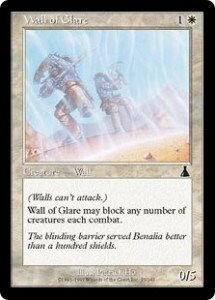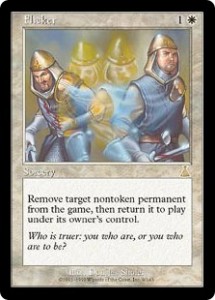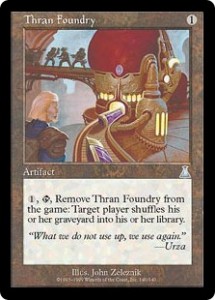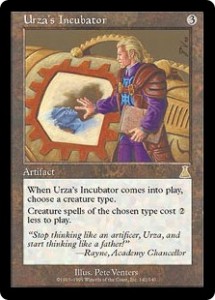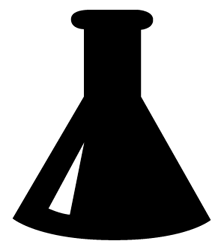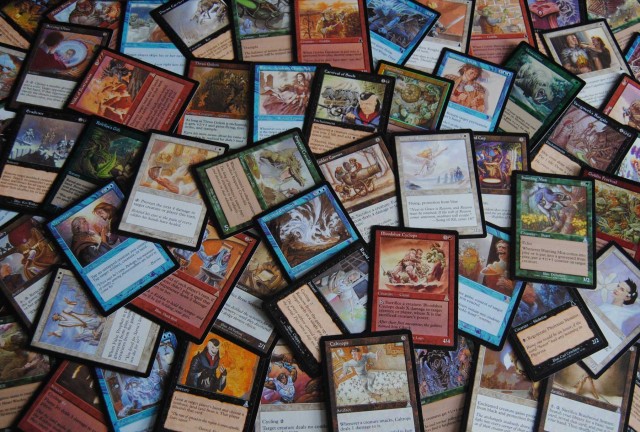
An Introduction to Urza’s Destiny
Urza’s Destiny was released on June, 23rd 1999 as the last expansion for the Urza’s Block. It was the first expansion to fully embrace the new rules introduced in Classic Sixth Edition, because it was the first set released since Classic Sixth changed the game of Magic: the Gathering.
The set continued the 143 card set for expansions, as was set forth in Exodus, Stronghold, and Urza’s Legacy. It also had the same rarity breakdown as those sets at 55 commons, 44 uncommons and 44 rares. The color breakdown was 25 Black cards, 25 Blue cards, 25 Green cards, 25 Red cards, 25 White cards, 17 Artifacts and 1 Land.
The set was almost completely full of new cards, with the exception of two cards; Ravenous Rats a reprint from Portal Second Age and Wild Colos a functional reprint of Raging Cougar, with a different creature type, from Portal.
Urza’s Legacy had three main cycles; growing enchantments and lobotomy spells, both based upon Tempest cards, and reveal spells (which actually had two cards in each color a Scent and a Seer).
The growing enchantments of Archery Training for White, Festering Wound for Black, Incendiary for Red, Momentum for Green and Private Research for Blue, were all based off of Legacy’s Allure from Tempest, although these were all creature enchantments as opposed to Legacy’s Allure which was a straight enchantment.
All of these cards allowed you the ability to put a counter on it, if you chose to, at the beginning of your upkeep and the subsequent ability was based upon the number of counters on the card. There was an additional Artifact with this kind of ability in Powder Keg, as well.
The Lobotomy spells; Eradicate for Black, Scour for White, Sowing Salt for Red, Splinter for Green and Quash for Blue, were all based on a different Tempest card: Lobotomy. Except that each of the colors targeted a different type of card; Eradicate for non-Black creatures, Scour for Enchantments, Sowing Salt for nonbasic Land, Splinter for Artifacts and Quash for Instant or Sorcery spells. Of these, Black’s Eradicate, White’s Scour and Blue’s Quash were the most commonly used and could be deadly to combo decks.
The other cycle was the reveal cards of the Scents and Seers. Each of these cards allowed you to do something x times, where x was the number of cards of the correlating color you reveal from your hand. The scents were Instants, while the Seers had the same function of the Instants as an activated ability.
For Black it was Scent of Nightshade and Nightshade Seer to give target creature -X/-X until end of turn, for Blue it was Scent of Brine and Brine Seer as a Power Sink, for Green it was Scent of Ivy and Ivy Seer to give target creature +X/+X until end of turn, for Red it was Scent of Cinder and Cinder Seer to deal X damage to target creature or player and for White it was Scent of Jasmine and Jasmine Seer to gain X times two life.
The Scents cost one colorless and one colored Mana, while the Seers cost three colorless and one colored Mana and had an activated ability one less colorless Mana than their casting cost. In fast decks the Scents were usable, but the Seers were not, because if you don’t have a hand to reveal cards, three Mana to gain two life or deal one damage is an expensive way to play.
There was an artifact that functioned like a Seer and that was Metalworker, but the only activation cost was tapping Metalworker and you revealed Artifacts in your hand for two colorless Mana per artifact revealed. This was a huge Mana advantage for Artifact decks and Metalworker only cost three colorless Mana.
While it may seem like Urza’s Destiny borrowed a lot from Tempest, it also followed in Stronghold’s footsteps of having one Land that was a Legendary Land.
The Land of Urza’s Destiny: Yavimaya hollow, Legendary Land
The sole Land of Urza’s Destiny was the Legendary Land Yavimaya hollow. It could be tapped for one colorless Mana or it be used to to regenerate target creature by paying the small activation cost of one Green Mana and tapping the hollow.
Similar to the lone Land of Stronghold, Legendary Land Volrath’s Stronghold, this could provide Mana, although it was colorless, but was used mainly for its other ability, in the case of the hollow to regenerate creatures.
Unlike, Volrath’s Stronghold, Yavimaya hollow didn’t see a lot of playing time, because many fast Green decks of the time didn’t require regeneration and didn’t want to be stuck with the hollow as the only Land in an opening hand. This is because it didn’t produce Green Mana, just colorless, but it had to have a drawback. If it had generated Green Mana, this card would have seen a ton of use, but would have been deemed too powerful.
As such, it wasn’t a gamble speed Green decks were willing to take, but speed Shivan decks, focused on getting big Red creatures out fast with Green Mana sources, gambled on the hollow to be able to regenerate Shivan Dragons or any other big Red creature they could cast. As with many cards, it is in how you use them, but with the hollow, its practical uses were limited at that time.
The Color Black in Urza’s Destiny: Discard, Destruction, and Power
Black returned to its classic roots in Urza’s Destiny with reanimation, discard, destruction and some added power.
The reanimation starts with Apprentice Necromancer, which is a 1/1 for one colorless and one Black Mana that can be sacrificed to create a Ball Lightning effect for one creature in your graveyard. If you can get an early discard of your own hand and have a big creature in the graveyard early one, this Wizard would be highly effective.
Body Snatcher on the other hand was a 2/2 for two colorless and two Black Mana, that had the added cost of discarding a creature card from your hand. This wasn’t really a cost, as much as it was an advantage. When Body Snatcher is put into the graveyard from play, you removed it from the game to put target creature card in your graveyard into play. With a Dark Ritual and a great opening draw, a turn two Body Snatcher could set up a reanimator deck very well.
Urza’s Destiny also had an anti-reanimator card in Rapid Decay. This cycling Instant, for one colorless and one Black Mana could “Remove from the game up to three target cards in a single graveyard.” For non-reanimator Black deck’s this was a must have sideboard card.
For straight up destruction, Attrition the enchantment for one colorless and two Black Mana, that gave you a Terror for one Black Mana and a sacrificed creature was highly utilized with cards like Breeding Pit and other creature token cards.
As far as damage, the now out-of-print Drain Life had an enlarged big brother in Soul Feast, which for two colorless and three Black Mana, made target player lose four life and you gained four life. The benefit here was that it wasn’t damage that could be prevented, it was loss of life.
Discard reemerged in Destiny with Encroach and Dying Wail. Encroach allowed you to look at a players hand and choose a nonbasic Land for them to discard. A few sets ago, Encroach would have seemed almost useless, but with the printing of more and more nonbasic Lands, this was very useful at a cost of just one Black Mana, the only downside being that it was a Sorcery and not an Instant. Dying Wail on the other hand was great effect for the cost.
For one colorless and one Black Mana, you could enchant a creature that when it died, target player had to choose and discard two cards. Now, it isn’t two cards at random, like Fallen Empires‘ hymn to Tourach, but it was two cards discarded for two Mana. It could be cast on a creature of yours to prevent attacks, or it could be cast on an opponent’s creature you’re going to kill, but either way it was effective.
For players looking to play passive Black, Plague Dogs was a good choice. At an expensive four colorless and one Black Mana to cast this 3/3, it was the ability that when it is put into the graveyard from play all creatures get -1/-1 until end of turn. It had the added ability of being sacrificed for a cost of two colorless Mana to draw a card, meaning the weakening of all creatures could be done, when you chose.
If you were looking for a replacement for the classic Unholy Strength, Twisted Experiment gave enchanted creature +3/-1 for one colorless and one Black Mana. While, it was useless on your own 1/1 creatures, it could be cast on your opponent’s Birds of Paradise as a form of removal. This made Twisted Experiment versatile enough to make it’s way in regular play in many Black decks.
If it’s quick Mana, you’re after Bubbling Muck was a one Black Mana Sorcery that could double your Swamps Mana production for the remainder of your turn. For Mana that is great for combos, look to Carnival of Souls.
If you can use Black Mana, to pump through activation abilities of creatures and artifacts, you could use Carnival of Souls, which was a cheap enchantment at one colorless and one Black Mana, which gave you one Black Mana and lost you one life, whenever a creature comes into play. Using this with a Breeding Pit or another source of creature production, could guarantee you plenty of Mana, but the ticking clock of losing life, would be you wouldn’t have much time to use it.
Two cards stood above the rest of Black in Urza’s Destiny; Phyrexian Negator and Yawgmoth’s Bargain.
Phyrexian Negator was a classic case of a card meant to be built into a deck for trading control of a creature with your opponent. This 5/5 with trample for two colorless and one Black Mana was a big cheap creature with a drawback. “Whenever Phyrexian Negator is dealt damage, sacrifice a permanent for each 1 damage dealt to it.”
The best example of utilizing this in a deck was the Black Blue trade deck, where you could get it out fast and attack with it until trading it to your opponent and using Tims to deal it damage and destroy everything they have in play. In addition, one Icy Manipulator keeping it tapped completed the deck, but it was versatile.
But the big news for Urza’s Destiny Black, and possibly from the set as a whole, was Yawgmoth’s Bargain, a more expensive and more powerful replacement for the now out-of-print Necropotence. It was double the cost at four colorless and two Black Mana, instead of three Black Mana, of it’s predecessor, but it was pay a life to draw a card, without waiting until the end of your turn to draw.
The flexibility of Bargain, made the lamenting of Necropotence a thing of the past quickly, although decks that utilized Bargain still went by the name of Necropotence decks.
The Color Blue in Urza’s Destiny: Control Control Control
Blue’s ability to control the game was greatly enhanced in Urza’s Destiny and that is saying something considering that the only Counterspell type cards were the Power Sink abilities of the Brine Seer and Scent of Brine.
With the growing number of powerful enchantments in Magic form the Rath Cycle of the Tempest Block and from the Urza’s Block, Aura Thief and Iridescent Drake gave Blue some powerful enchantment manipulation.
Aura Thief was a 2/2 with flying for three colorless and one Blue Mana that when it was put into the graveyard from play gave you control of all enchantments, with the exception of local enchantments. This was very powerful, in it’s own right, because many combos of the day included enchantments and you were basically stealing them all.
Meanwhile, Iridescent Drake was a 2/2 with flying, with the same cost as Aura Thief that could be enchanted with an enchantment from the graveyard when it came into play. The power of Iridescent Drake was that the enchantment could come from any graveyard, not just your graveyard, something that was abused in Black Blue discard decks.
Fatigue was a cheap way to slow down your opponent. From one colorless and one Blue Mana, Fatigue was a Sorcery that forced target player to skip their next draw step. At such a cheap cost, any opponent that seems to be Mana screwed, could be slowed up even further, by denying them a draw.
Donate made many cards with a huge downside extremely playable. For two colorless and one Blue Mana, Donate was a Sorcery that allowed you to give target permanent you control to your opponent. In this set alone, decks were built with Donate paired with Phyrexian Negator, but there were many other creative uses as well. One of my favorite being giving a nonBlack deck control of Demonic hordes and watching their Mana pool dwindle, until it is no more.
Disappear was a reusable Boomerang for creatures. It was expensive to cast at two colorless and two Blue Mana, but for one Blue Mana you could return enchanted creature and Disappear to their owners’ hands. This meant that with a Counter in your hand, you could bounce back and Counter the creature that was doing you in, and then pick your next target and continue to you win or run out of Counters.
Urza’s Destiny also returned a classic card to Blue with Temporal Adept, a new more powerful Time Elemental. The casting costs were similar, the Wizard at one colorless and two Blue Mana compared to the two colorless and one Blue Mana of the Elemental, but that’s where the Wizard, Temporal Adept starts to gain advantage.
Temporal Adept’s activated ability to return target permanent to owner’s hand, was three Blue Mana, as opposed to two colorless and two Blue Mana. It was a 1/1 as opposed to a 0/2 and it didn’t have the downside of dealing you five damage it if attacks or blocks, before being destroyed.
This cheaper Time Elemental, without the combat backlash was welcomed into open arms since Time Elemental had been out-of-print since it’s last printing in Fifth Edition.
Classic Sixth Edition saw the end of Binding Grasp, which had replaced Control Magic and was then replaced by Abduction, but the loss of Control Magic was no longer something in player’s minds the moment they laid their eyes on Treachery.
Treachery was, in fact, the best replacement for Control Magic that could have ever been conceived. It allowed you to gain control of target creature and it cost three colorless and two Blue Mana, but it was basically free, because when it was cast, it allowed you to untap up to five Lands.
For Blue, always looking to keep Lands untapped for Counterspells or at least the threat of Counterspells, this was huge. You were able to steal a creature and didn’t have to tap out. It was simply, one of the biggest control cards to hit Blue, since Force of Will in Alliances.
Even more control could be had with Opposition a two colorless and two Blue Mana costing enchantment. Opposition allowed you to “Tap an untapped creature you control: Tap target artifact, creature. or land.” In many control Blue deck’s that were based around an army of Tims, the flexibility to tap a Tim to do damage or tap a creature was useful, turning every Tim, into an Icy Manipulator as well.
One of the bigger creatures for Blue in Urza’s Destiny was Blizzard Elemental. A 5/5 flyer for five colorless and two Blue Mana that could be untapped for three colorless and one Blue Mana. Although the activation cost was high, it was still useful. Urza’s Destiny also gave Blue a decent card draw advantage.
Thieving Magpie was a 1/3 flyer that allowed you to draw a card, whenever it dealt damage to one of your opponent’s. Kingfisher was a 2/2 flyer that allowed you to draw a card when it is put into the graveyard form play, but it was the enchantment Mental Discipline that really helped card draw.
Mental Discipline cost one colorless and two Blue Mana to cast and essentially made everything in your hand have cycling, for an activation cost of one colorless and one Blue Mana. In a straight Blue deck, that’s basically cycling for every card, cincluding Land. If paired with Alliances’ Soldevi Digger, you could endlessly discard cards to get to what you want, while recycling them with the Digger to the bottom of your Library, gaining you a card advantage without shrinking your Library.
But the ultimate in card draw advantage came from the Legendary Wizard Rayne, Academy Chancellor, which was in fact a Wizard Legend.
When Rayne is in play, anytime a spell or ability controlled by an opponent targets you or a permanent you control, you get to draw a card. If Rayne is enchanted you may draw an additional card. Put out Rayne against a Red Burn deck and your opponent won’t be happy with all of the options you have at your disposal.
The Color Green in Urza’s Destiny: Elves and Creature Manipulation
Urza’s Destiny Green was a return to Elves, the Yavimaya clan, big creatures and getting creatures out fast.
The first Elf of note was heart Warden, a more expensive Llanowar Elf with an added bonus. The heart Warden cost one colorless and one Green Mana for a 1/1 that could be tapped to add one Green Mana to your mana pool, or could be sacrificed for a cost of two colorless Mana to draw a card. This added card draw function made the additional Mana casting cost well worth it, late in games when you had more Mana than you knew what to do with.
Taunting Elf was a 1/1 for one Green Mana with a built in Lure. This was a great way to get more Elves through in a mass attack and could be easily regenerated with Yavimaya hollow. Elvish Lookout on the other hand was a 1/1 for one Green Mana that could not be the target of spells or abilities. Both of these Elves were useful, but second to heart Warden it was Elvish Piper that won the day.
Elvish Piper was a 1/1 for three colorless and one Green Mana that had a great ability. For one Green Mana, you could tap Elvish Piper to “put a creature card from your hand into play.” Since abilities are harder to counter and it’s activated ability cost is only one Green Mana, this was great to get out early.
Gamekeeper was another useful Elf for getting out big creatures. This 2/2 Elf cost three colorless and one Green Mana to cast and when it was put into the graveyard from play, you had the option to remove it from play and reveal the top card of your library until a creature is revealed and that creature is put into play. This is best done with a Sylvan Library, because all non-creature cards revealed this way go into the graveyard.
In the history of Magic Rofellos, Llanowar Emissary was the first printed Elf Legend. Errata made Alliances‘ Kaysa not just a Legend but a Legendary Elf Druid and Tempest‘s Eladamri, Lord of Leaves not just a Legend but a Legendary Elf Warrior.
That being said, no errata was needed, because Rofellos was printed as an Elf Legend. That being said, Rofellos cost two Green Mana to cast for a 2/1 that can be tapped to add one Green Mana to your mana pool for each forest your control. Which is pretty good, although in a straight elf deck, I would prefer Priest of Titania.
The region of Yavimaya and the creatures therein were first introduced to Magic players during Ice Age and have expanded since then. Two Druids from Yavimaya appeared in Urza’s Destiny; Yavimaya Elder and Yavimaya Enchantress.
Yavimaya Elder was a 2/1 that when put into the graveyard from play allowed you to search your library for two basic lands and put them into your hand. This could happen when you needed it the most, because you could pay to a sacrifice the Elder to draw a card.
Yavimaya Enchantress was similar to Verduran Enchantress in that they both gave you boosts because of enchantments. But whereas the Verduran allowed you to draw a card, when the enchantment was cast, Yavimaya Enchantress received a +1/+1 boost for each enchantment in play, regardless of ownership. With the enchantment heavy Urza’s Block, this was a great play if you were playing Green.
What happens when you cross Overrun with Giant Growth? You get Magnify, a one Green Mana costing Instant that gives all creatures +1/+1 until end of turn. I compare it to Overrun and Giant Growth because it was at times called a massive Giant Growth or a mini-Overrun, but it truth, it was different than both, because it gave all creatures the buff, not just your creatures, so it had to be timed right to be effective.
Of course, Green has always been about more than just elves, it has had its share of big creatures, too and it had three big ones in Destiny; Ancient Silverback, Emperor Crocodile and Thorn Elemental.
Ancient Silverback was a 6/5 with regeneration for four colorless and two Green Mana. Although it didn’t have trample, it could be given trample with ease and was easy to cast in straight Green deck’s with so much Mana readily available.
Emperor Crocodile was a 5/5 four three colorless and one Green Mana, which only had the minor drawback of being sacrificed when no other creatures were in play. That being said, even if they picked off a few of the Elves around it to make you sacrifice it, the damage would have been done. Lastly, of the big creatures was Thorn Elemental, a 7/7 for five colorless and two Green Mana, that had what many called “ultimate trample.”
“Thorn Elemental may deal its combat damage to defending player as though it weren’t blocked,” and in most cases, because of this, it would not be blocked. With such powerful large creatures, Elvish Piper was that much more useful, at casting them with just a single Green Mana, instead of their actual casting costs.
Pattern of Rebirth was another way to get a big creature out faster. It was an enchant creature for three colorless and one Green Mana, that when the enchanted creature was put into the graveyard from play, allowed you search your library for a creature card and put it directly into play. Again, this wasn’t just a cheap way to get your creature cast, it was another way to avoid having your creatures countered, which was a huge advantage, at times more-so than the cheap cost.
The Color Red in Urza’s Destiny: Goblins, Land Destruction, and Damage
Where there is smoke there is fire and where there be Elves there be Goblins, it’s the nature of the world and the nature of Magic. Red wasn’t all Goblins, but they were a part of Destiny as were a few big creatures, direct damage and destruction.
Of the many Goblins in Destiny, it was the 3/3 Goblin Marshal that stood clearly above the rest. This echo Goblin with the massive casting cost of four colorless and two Red Mana, put two 1/1 Goblin Tokens into play when it came into play, and two more when it was put into the graveyard from play, meaning at minimum you would be getting four 1/1 Goblin tokens. But in spite of its cost, plenty of players tried to bounce it back or reanimated it to continue the marshaling of goblins, forming an army.
All of those goblins, token or otherwise, could be found at the Goblin Festival, a one colorless and one Red Mana costing enchantment.
Goblin Festival was one of the fun “flip a coin” cards, where if you won the flip, you could deal one damage to target creature or player, but if you lost the flip, one of your opponent’s (of your choice) gained control of Goblin Festival. Although not used regularly, Goblin Festival was a fun play in any game, especially if you felt lucky.
There were big creatures too, notably Covetous Dragon and Bloodshot Cyclops. Covetous Dragon was a 6/5 flyer for four colorless and one Red Mana, but it only remained in play as long as you controlled an artifact. This was similar to Emperor Crocodile, in that it it was cheaper than a normal creature of its size would be, but it had a small drawback, and controlling an artifact for Covetous Dragon was a small drawback. Even if it did give your opponent another way of removing the dragon from play, it was well worth it.
Bloodshot Cyclops was a 4/4 for five colorless and one Red Mana, that contained the tap activated ability of Fling. This was a great addition to any deck, because having the ability to Fling a creature at your opponent, without having a hand is wonderful. Yes, it cost a decent amount of Mana, but you were getting a solid 4/4, and 4/4’s aren’t easily dealt with.
For more conventional damage, Urza’s Destiny gave Red players a plethora of options. Reckless Abandon was a one Red Mana costing Sorcery, with the added cost of sacrificing a creature to deal four damage to target creature or player. This was a close to a Goblin Grenade from Fallen Empires as you could get, excepting that it only dealt four damage and not five. Still, one Red Mana and a sacrificed 1/1 Goblin to deal four damage is a sweet deal.
Flame Jet was a cycling Incinerate that could only target players. Because it had cycling, most players used it, all the while lamenting that it was a Sorcery and not an Instant. But since it dealt three damage and not the two of the current cheap direct damage spell of Shock, it was played anyway. Landslide was another one Red Mana costing direct damage spell, and even though it was a Sorcery it was used as a last resort, because when it was cast, you could sacrifice any number of Mountains and that number was equal to the damage dealt to target player.
Repercussion was an enchantment meant to help weenie Goblin decks. “Whenever a creature is dealt damage, Repercussion deals that much damage to that creature’s controller.” Of course, it wasn’t wise to cast against another weenie deck, or even against an opponent with a Pestilence in play, it could really speed up a game, in your favor if you timed it right.
Æther Sting followed in the footsteps of Æther Flash from Weatherlight. Although instead of dealing two damage to a creature when it came into play, it dealt one damage to creature’s controller when the creature came into play. Luckily unlike Æther Flash, it didn’t affect you, only your opponent’s making it an obvious sideboard card against weenie decks.
Impatience was another passive damage spell for Red, dealing damage to each player at the end of their turn if they didn’t play a spell. This also affected you, so timing was everything, but against some decks, it could really make every turn count.
By the time Urza’s Destiny was released, Haste was owned by the color Red. There were plenty of ways to give haste to a creature, including Weatherlight’s Fervor, which gave all creatures you control haste, but Mark of Fury was another effective way to give creature’s haste, over and over.
Mark of Fury was a creature enchant that cost one Red Mana and gave enchanted creature haste, but the enchantment would then be returned to owner’s hand at the end of the turn. This allowed you to reuse Mark of Fury as long as you needed to and at a cost of one Red Mana, it was cost effective.
Trumpet Blast was a brilliant offensive for Red, especially for Goblin decks. As a two colorless and one Red Mana costing Instant, it gave all attacking creature +2/+0 until end of turn. No it didn’t give trample, but if you know that three of your 1/1 Goblins will get through in an attack, why not make sure those Goblins are 3/1’s? It just makes sense and it was a sign that Goblins and Red were catching up to the speed and power of Elves in Green.
One of the most powerful spells in Magic is a targeted mass destruction spell and Wake of Destruction was that, a targeted Armageddon. For three colorless and three Red Mana you could destroy target Land and all Lands of the same name. For mono color deck’s this could be downright apocalyptic, but for any other deck, removing half of you mana pool or all of one color, could be just as destructive. Land destruction was back and Wake of Destruction was leading the charge.
The Color White in Urza’s Destiny: Protection, a New Wrath of God and More
Unlike some of the other colors White didn’t return to anything because it maintained a constant stream of what it does best from set to set; protection, healing, and power.
First, let’s talk about Master healer, the Samite healer on steroids, that cost three more colorless Mana, had three more toughness as a 1/4 and prevented three more damage at total of four. That’s damage prevention on a massive scale. And for what you couldn’t prevent there were options for boosting your creatures as well.
Serra Advocate, was a 2/2 flying angel that, could be tapped to give target attacking or blocking creature +2/+2 and it seemed like a bargain at just three colorless and one White Mana to cast. While Solidarity was the counter to Red’s Trumpet Blast as a three colorless and one White Mana costing Instant that gave all of your creatures +0/+5 until end of turn. While I will admit that in some cases Castle, an enchantment, for the same cost, that will grant your untapped creatures +0/+2 can be more useful, sometimes you need more than just +0/+2.
White has long been the a home for amazing Walls and Wall of Glare is no exception. For one colorless and one White Mana, Wall of Glare was a 0/5 that could block any number of creatures each combat. For a turn two wall, to be able to block a bunch of those first turn drops of your opponent and keep them at bay for at least a turn or two, made Wall of Glare something to consider in any deck with White in it.
Introduced at the beginning of the Urza’s Block in Urza’s Saga was Law and Grace as creatures and spells with protection from Black and Red respectively, both returned at the end of the Block in Urza’s Destiny with the addition of Duty, or protection from Green and Reason, or protection from Blue.
Mask of Law and Grace gave enchanted creature protection from Black and Red, while two more Voices joing Law and Grace; Voice of Duty and Voice of Reason, and both were as those who came before, 2/2’s with flying, protection from a color and cost three colorless and one White Mana, and all were Angels.
Of all of the things that White gained from the Urza’s Block, enchantment manipulation was one of them and Opalescence was near the top in terms of sheer power. It cost two colorless and two White Mana and turned every other global enchantment into a creature with power and toughness equal to each enchantment’s converted mana cost.
Depending on what you were playing and what your opponent had on the board in terms of enchantments, this could be game over.
But the enchantment manipulation didn’t stop there. Academy Rector was a 1/2 cleric that cost three colorless and one White Mana, that when it went into the graveyard from play allowed you to search your library for an enchantment and put it directly into play.
With White’s stranglehold on powerful enchantments, this was even better than Mirage‘s Enlightened Tutor, because it put the enchantment directly into play.
If your opponent manages to destroy one or more of your enchantments Replenish can undo their destruction. For three colorless and one White Mana, Replenish will return all enchantments from your graveyard to play. This kind of mass enchantment regeneration can be a complete game changer, especially if Opalescence is one of the enchantments, because it’s essentially an instant army.
Where Red and Green had big creatures with drawbacks; Emperor Crocodile and Covetous Dragon, White had a cheaper, medium-sized creature in Tethered Griffin. The Griffin was a 2/3 flyer that only cost one White Mana, but had to be sacrificed if you controlled no enchantments. All things being equal, Tethered Griffin probably saw more playing time than the larger Crocodile and Dragon. But it wasn’t all about enchantments, White still had some mass destruction up its sleeve.
False Prophet was a 2/2 for two colorless and two White Mana, but when it is put into a graveyard from play, it functions exactly like a Wrath of God. Now, having a Wrath of God in your hand is great, but having it on the board, in the form of a creature, like False Prophet, creates an entirely different game. Your opponent knows it is there and that creates tension, which can only benefit you.
Except that False Prophet doesn’t destroy all creatures, it removes all creatures from the game, rendering reanimator deck’s null and void. But it had a partner in crime in Flicker in the set.
Flicker was a Sorcery for one colorless and one White Mana, that could have been called the “combo maker.” It’s effect was “Remove target nontoken permanent from the game, then return it to play under its owner’s control.”
Play that with a big creature and Wrath of God or False Prophet or Catastrophe. Play it with Nevinyrral’s Disk or Jokulhaups. It doesn’t really matter, the point is, it only cost two Mana to cast and it serves you and only you. With Flicker you can clear the board, except for whatever you choose and that is power and something only White can do.
The Artifacts of Urza’s Destiny: Old Artifacts Reborn and More
With the Artifacts of Urza’s Destiny, there were some new artifacts, but it also reintroduced old concepts with new costs.
Braidwood Cup was the new Fountain of Youth and although it wasn’t a free drop like the Fountain, it’s activated ability was only Tap, so it could be used more often, while leaving your Mana alone for other pursuits.
Speaking of Mana, Thran Dynamo was kind of like the new Mana Vault as it could be tapped for three colorless Mana. But like the Cup and the Fountain, Dynamo didn’t cost one Mana like the Vault did, it cost four Mana but did not have an untap cost. Both Braidwood Cup and Thran Dynamo cost more than their original counterparts, but that didn’t stop them from being used.
One card that was slightly better than it’s original was Thran Foundry, a more versatile Feldon’s Cane despite there only being two differences between the two cards.
The Foundry’s activated ability cost one colorless Mana and Tap, as opposed to the Cane, which was just Tap, but it was worth it because of the other difference. Unlike Feldon’s Cane, Thran Foundry allowed you to target a player. This means that once your opponent has manipulated their graveyard or their library in order to get the draw they want, you can undo all that work.
Caltrops joined Tempest‘s Watchdog in being solid protection against weenie decks. Caltrops cost three colorless Mana for “whenever a creature attacks, Caltrops deals 1 damage to it.” That will stop a lot of those early attacks, but once the buffs come, you better have your army ready.
For Artifact control, Junk Diver was a 1/1 flyer for three colorless Mana that allowed you to return another target artifact from your graveyard to your hand when it died. Now this was weaker than some of the creatures with graveyard abilities like Body Snatchers, because it didn’t put the card from the graveyard directly into play, but if you want to get back your artifact, getting it into your hand is still better than it staying in the graveyard.
One of the more intriguing artifact creatures from the entire Urza’s Block was Masticore, a 4/4 for four colorless Mana that had a large upkeep and great abilities. The upkeep was discarding a card, so unless a howling Mine was in play, the Masticore’s time was numbered. If you could keep it in play, it was a 4/4 that could be regenerated for two colorless Mana, but it’s other ability was the reason people used it.
“Two colorless Mana: Masticore deals 1 damage to target creature,” which seems like a letdown, because you would want to target players, too. But players of Red and Black used Masticore to remove creatures from the game that had Protection from Black or Red. Masticore’s damage was colorless, making it harder to protect creatures from.
But by far the better Artifact creature from Destiny was Thran Golem. Costing five colorless Mana to cast and only being a 3/3 was just the start. “As long as Thran Golem is enchanted, it gets +2/+2 and gains flying, first strike, and trample.” And if you have the five Mana to cast the Golem, hopefully you have an enchantment lying around… perhaps Urza’s Saga’s Cloak of Mists to make this 5/5 with tons of abilities unblockable as well!
Storage Matrix was a great way to slow down the game by limiting untapping, but it was the first artifact to state the new tap rule. The rule text starts with “As long as Storage Matrix is untapped,” which was one of the more jarring changes wrought from Classic Sixth Edition. Although, it wasn’t as efficient as the old Winter Orb / Icy Manipulator combo used to be, it could still be fun.
Scrying Glass was very similar in mechanics to Tempest‘s Cursed Scroll only reversed. You choose a number and a color and target opponent reveals their hand and if they have the exact number selected of the chosen color you get to draw a card. This allows you to spy on your opponent’s hand and gain card advantage.
However, I’ll always be partial to letting my opponent know what’s in my hand to deal them damage with Cursed Scroll. The other downside was that like Cursed Scroll the activated ability cost three colorless Mana, which was a on par for two damage but seemed excessive for the chance at drawing just one card.
The last artifact of note is from the set’s and this Block’s namesake of Urza, which makes that artifact Urza’s Incubator. For three colorless Mana you can choose a creature type when the Incubator is played and creature spells of the chosen type cost two colorless Mana less to play. For tribal deck’s this was a cheaper more effective Stone Calendar.
In Conclusion Urza’s Destiny
Closing the book on the Urza’s Block, Destiny borrowed a lot from the annals of Magic’s history and from some recent history in the mechanics it borrowed from the Tempest Block.
It wasn’t a groundbreaking set, but it didn’t have to be. After the rule changes in Classic Sixth Edition, Urza’s Destiny returned Magic to the norm, by introducing new cards and reintroducing variations on some old cards.
But what it did was stabilize Magic, after the turmoil of Classic Sixth Edition’s rule changes. Urza’s Destiny was not only the perfect set to complete the Urza’s Block, it was the perfect follow up to Sixth. It didn’t generate any controversy and simply added to the game, which is what expansion sets are supposed to do.
It was exactly the set Magic needed at a time when it needed it the most. And for not being shocking or controversial, it was a huge success.
